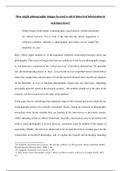How might photographic images be used to elicit historical information in
oral interviews?
Orality lingers in the depths of photographic consciousness, silently petitioning
for critical recovery. Yet so vital is the link that the merest suggestion is
sufficient reminder; allusions to photography and orality can be caught like
butterflies in a net.1
Here, Alfred Appel reminds us of the important symbiotic relationship between orality and
photography. This essay will argue that there are a plethora of ways to use photographic images
in oral interviews in pursuit of the ‘critical recovery’ of historical information.2 To prescribe
one, all-encompassing answer to ‘how’, is to provide an over simplified answer which fails to
reflect the complexities and messiness of real-life research. Instead, there must be an emphasis
on the flexibility of ways to integrate photographic images into oral interviews, depending
principally upon the needs of the research scenario- ‘the methods should serve the aims of the
research, not the research serve the aims of the method’.3
It will argue this by considering three important stages of the research process in which the use
of photographs needs to be carefully considered. Firstly, during the selection of photographs,
researchers must decide whether they are familiar to the interviewee or previously unseen,
whilst operating within an ethical framework. Secondly, interviewees may be presented with
either a single photograph or several, however, researchers must be mindful of the impact of
materiality. Thirdly, the interview should aim to be an open discussion, creating space for the
construction of historical knowledge, and, to explore the layered and developing meanings
1
M. Langford, Suspended Conversations: The Afterlife of Memory in Photographic Albums (Montréal, Québec:
McGill-Queen's University Press, 2008) p.198.
2
M. Langford, Suspended Conversations, p.198.
3
S. Pink, Doing Visual Ethnography: Images, Media and Representation in Research (London: SAGE, 2007)
p.4.
, within photographs. Considering these stages of the research process is intended to provide a
basis for future research as ‘specific uses should be creatively developed within individual
projects’.4 But first, to understand the present and future use of photographs in oral interviews,
an understanding of their past use is required.
Historiography of Photography and Orality
The use and value of photographs has not always been acknowledged in social science and
historical research. There is a long-running debate between positivists, who argue that images
relay reliable information about the external world, and structuralists, who assert that they do
not. Positivists attempt to ‘peer through the picture to glimpse the reality beyond, while the
latter group focuses attention on the picture itself, its internal organisation, the relationship
between its parts and between this picture and others in the same genre’.5 It is possible to
simultaneously reject both the positivist and structuralist view; images are neither a mirror of
reality or merely a system of signs and conventions. Instead, images are imbued with
conventions that filter information about the outside world, but, do not exclude it. Thus,
combining photographs and oral interviews helps to bridge the gap between the photograph
and reality, calling to attention what cannot be observed.
Theoretically, the relationship between photography and oral history is well established in the
historians’ belief that ‘without oral history, as without photography, history was dead’.6
However, methodologically, it was only in 1957 John Collier first described photo-elicitation
(the use of photographs during the interview process). Collier promoted the use of ‘open-ended
methods, viewing an interview as an exchange that, although initiated and guided by the
interviewer, aims to grant an interviewee greater space for personal interpretations and
4
S. Pink, Doing Visual Ethnography, p.5.
5
P. Burke, Eyewitnessing: the uses of Images as Historical Evidence (London: Reaktion Books, 2001) p.184.
6
A. Freund, and A. Thomson (eds), Oral History and Photography (New York: Palgrave Macmillan, 2012) p.2.




